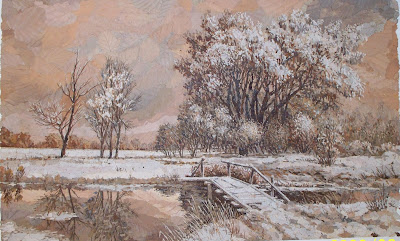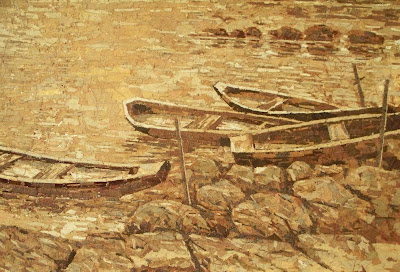 This is one dream of mine came true - I’ve visited Urkovka gallery. First I’ll tell you a little about the founder of this gallery Alexander Urkov. He is known in Nizhni Novgorod as professional theatre painter, who worked more than 40 years as a scene-painter and art director in the theatres of Krasnoyarsk, Kansk, Maikop, Karaganda, Moscow, St Petersburg, Pskov, Tomsk, Arzamas. In Nizhni Novgorod he was working as an art director in the Drama Theatre from 1976 till 1986. In 1998 he opened his own gallery Urkovka, where he exhibits his works, created in the technique of “floristic mosaic” - that’s the way he calls it. Certainly Alexander was already acquainted with similar works, in which plant materials are used, but he came to that kind of art from a position of professional painter, who can even paint in mud: it lying under the feet - why we can’t use autumn leaves instead of colours? He even has a poem about this.
This is one dream of mine came true - I’ve visited Urkovka gallery. First I’ll tell you a little about the founder of this gallery Alexander Urkov. He is known in Nizhni Novgorod as professional theatre painter, who worked more than 40 years as a scene-painter and art director in the theatres of Krasnoyarsk, Kansk, Maikop, Karaganda, Moscow, St Petersburg, Pskov, Tomsk, Arzamas. In Nizhni Novgorod he was working as an art director in the Drama Theatre from 1976 till 1986. In 1998 he opened his own gallery Urkovka, where he exhibits his works, created in the technique of “floristic mosaic” - that’s the way he calls it. Certainly Alexander was already acquainted with similar works, in which plant materials are used, but he came to that kind of art from a position of professional painter, who can even paint in mud: it lying under the feet - why we can’t use autumn leaves instead of colours? He even has a poem about this.
Urkov’s gallery is situated in the basement of the house he lives in. This is the house, st.
Bolshaya Pokrovskaya, in the center of Nizhni Novgorod.
There are no windows and that’s why sunlight effect is minimal. But it stays some moisture, like in any basement, - take notice on this, - and the works have no covering at all: no glass, no lacquer.

There are 4 rooms there - in 3 of them Urkov’s pictures are placed, 4th room contains Anisimov’s works (I’ll tell about him later). There are not so much pictures if we know that Alexander creates 26-27 works per year. Pictures are in good demand, therefore many of them are sold . Works are in 40х50 and 50х60 sizes mostly, but there are even bigger. The lowest price - $400. Apart
from pictures in gallery you can also find there different items, made from roots, temples - from water-melon’s seeds, from
 matches and so on.
matches and so on.My kids were really interested in them - if you put a coin in the slot, the temple begins to turn around, and the light in its windows turns on. Children were playing till we had no more coins.
And these funny dumbbells are money boxes made of papier-mache. I threw coins in them too to come back here again sometime .

Here are photos of the Urkov pictures, disposed in his gallery:
 Whisper of Autumn
Whisper of Autumn The coldness
The coldness The crack willow in winter
The crack willow in winter
 The ant-hill
The ant-hillMore works by Urkov look here http://foto.mail.ru/mail/sesame69/Urkov or http://www.urkovka.narod.ru/gallery.html (website by Urkov).
I’m so glad that I had an opportunity to see Alexander’s works, because the photos don’t reproduce even half of their beauty and riches of the tints. Urkov usually use autumn leaves, but those that were under the snow whole winter, it means he collects them in spring. He prefers leaves that are thinner and don’t have glitter - they are all his brown tints. He also likes autumn leaves of different herbs, because they are thinner too and are convenient for work: leaves of nettle, burdock and other herbs with white downside.
Interesting material is autumn leaves of the garden violet (the way Urkov call it, but I think it’s rather viola ) - blackened and covered with something like pimples. He uses it to make trunks of the trees.
His favorite material for sky is sycamore maple (Acer pseudoplatanus). Snow in winter landscapes, grey hair on self-portrait - this is also maple, I even guess that it is summer sycamore maple with white downside. And autumn leaves have such warm tints - yellow, rose - and suits well for different sky tints. Sycamore maple leaves are thinner and softer than white poplar leaves.
Alexander told me that he necessarily leaves dried leaves to lay sometime on the window-sill, under sunlight, in order that they won’t change their colour in future. I understood that this procedure is being applied to the leaves, collected in the autumn. He dries leaves in a very primitive way - in magazines. And always irons them - to avoid microbes. Leaves that were collected in spring are also being cleaned and ironed.
Leaves that were collected in spring are also being cleaned and ironed.
As for the process of the work itself, the picture is being drawn on the thin paper (like newspaper’s but it is blank). The paper is moistened and strained on the stretcher. Then the artwork is being pasted. The most important moment here - to keep the exactness of the drawing. Leaves are pasted as a whole (sky) and in pieces, which we get when leaf is crumbled (crowns of trees). The thin branches and blades leaves are cut with a sharp scalpel. Here is close-up:




Urkov uses PVA glue. Finished works are ironed with a hot iron through the layer of gauze. In order that glue could stand high temperature, we should take one that is used for furniture.
A finished work is cut out and carried to the worksheet (white paper, glued on fibreboard).
Here is a photo of one of his first works (1984). The colours have changed a lot because he hadn’t much experience about which herbs preserve their colour and which don’t.
 Now I’ll tell you about Anisimov.
Now I’ll tell you about Anisimov.
Vladimir Anisimov is not an apprentice, but a follower of Urkov, inspired by his artwork. He is an engineer. He is a former naval officer, who worked more than 20 years on atomic submarines at utmost North. There he began to practice painting, graphic arts, wood engraving. Under the influence of Urkov’s works he devoted himself to floristics since 1997.
I liked his pictures very much, they are even more filigree. Here you can look at photos of his works:

Before flying away

The right coast of Oka

The Reflection
 Spring at Svetlojar
Spring at Svetlojar
More works by Anisimov look here: http://foto.mail.ru/mail/sesame69/Anisimov
At parting Alexander Urkov signed for me two books with his work’s photos. Here is his autograph (on the lower photo: Alexander Urkov and Vladimir Anisimov):


No comments:
Post a Comment